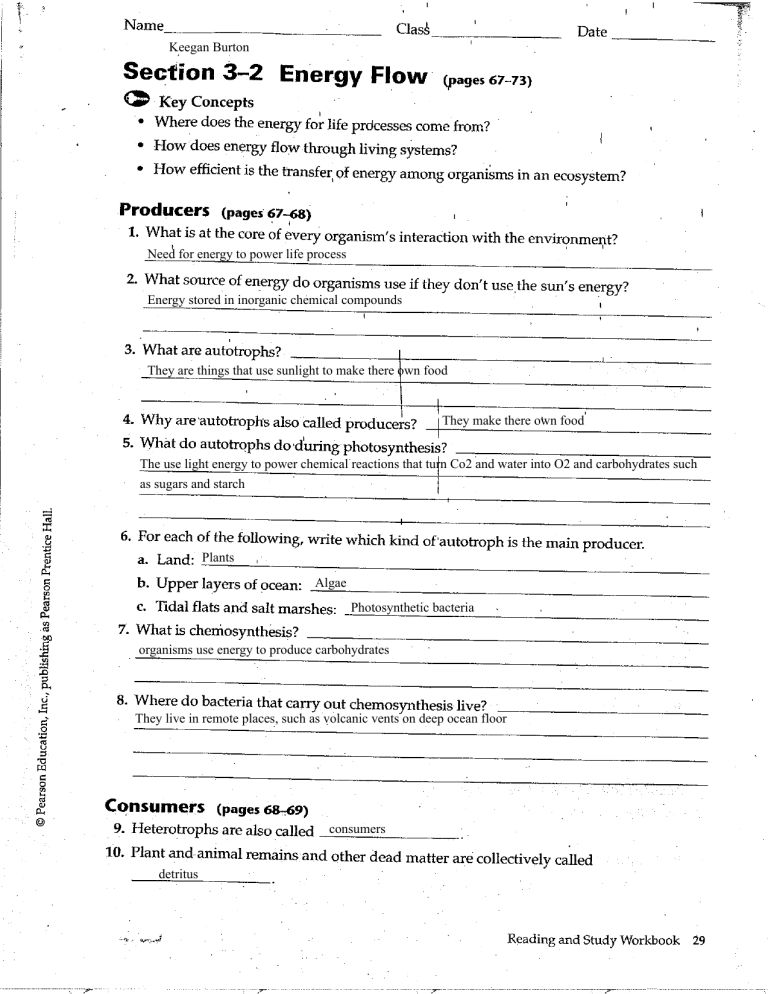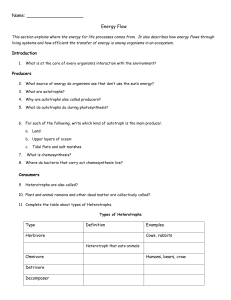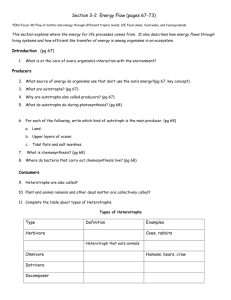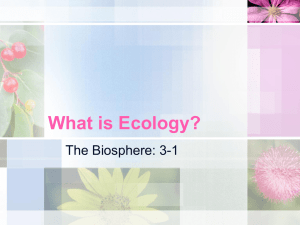
Name Clasé Date Keegan Burton Section 3—2 Energy Flow (pages 67-73) Key Concepts Where does the energy for life prdcesses come from? • How does energy flow through living systems? How efficient is the transferi of energy among organisms in an ecosystem? • • Producers 1. (pages 67-68) What is at the core of every organism's interaction with the environment? Need for energy to power life process 2. What source of energy do organisms use if they don't use the sun's energy? Energy stored in inorganic chemical compounds 3. What are autotrophs? They are things that use sunlight to make there own food They make there own food 4. Why are autotrophs also called producers? 5. What do autotrophs do during photosynthesis? The use light energy to power chemical reactions that turn Co2 and water into O2 and carbohydrates such as sugars and starch 6. 7. For each of the following, write which kind of'autotroph a. Land: Plants b. Upper layers of ocean: Algae c. Tidal flats and salt marshes: is the main producer, Photosynthetic bacteria What is cheniosynthesis? organisms use energy to produce carbohydrates 8. Where do bacteria that carry out chemosynthesis live? They live in remote places, such as volcanic vents on deep ocean floor Consumers 9. (pages 68-69) Heterotrophs are also called consumers and animal remains and other dead matter aré collectively called detritus 10. Plant Reading and Study Workbook 29 Name 11. Date Class Complete the table about types of heterotrophs. TYPES OF HETEROTROPHS Herbivore Carnivore Omnivore Detritivore Decomposer Cows, rabbits Heterotroph that gets energy by eating plants Heterotroph that eats animals Heterotroph that eats both animals and plants Heterotroph that eats dead matter Heterotroph that breaks down organic matter Feeding Relationships 12. Examples Definition Type Snakes, dogs, owls Humans, bears, crows Mites, earthworms, snails, crabs Bacteria, Fungi (pages 69-71) How does energy flow through an ecosystem? It flows through an ecosystem in one direction from sunlight to autotrophs to heterotrophs 13. Complete the table about feeding relationships. FEEDING RELATIONSHIPS Relationship Description Food Chain A series if steps in which organisms transfer energy by eating and being eaten Food Web A network of feeding relationships 14. What does a food web link together? All food chains in ecosystem 15. What is a trophic level? Its a step in food chain 16. In 17. a food web, what organisms make up the first trophic level? Producers oq What does a consumer in a food chain depend on for energy? Depends on tropic level Ecological Pyramids (pages 18. What is an ecological pyramid? 72-73) Diagram that shows energy in a trophic level Why is it that only part of the energy stored in one trophic level is passed on to the next level? Because organisms use much of the energy for there life 30 tri 60 below them 19. o Chapter 3 o Name 20. Date Complete the energy pyramid by writing the source of the energy for the food web and how much energy is available to first-, second-, and third-level consumers. Heat Heat H eat Heat Third-level consumers Second-level consumers First-level consumers 100% Producers 21. What is biomass? Total amount of living tissue in a trophic level 8 22. What does a biomass pyramid represent? Amount of potential food in each trophic level 0 23. What does a pyramid of numbers show? Shows the number of organisms at each trophic level 24. Why can each trophic level support only about one tenth the amount of living tissue of the level below it? Because it gets less energy from the level below it Reading o 0-4 Skill Practice When you read about complex topics, writing an outline can help you organize and understand the material. Outline Section 3—2 by using the headings and subheadings as topics and subtopics and then writing the most important details under each topic. Do your work on a separate sheet of paper. Reading and Study Workbook 31 Date Class Name Section 3—3 Cycles of Matter (påges 74-80) Key Concepts • • • How does matter move among the living and nonliving parts of an ecosystem? How are nutrients important in living systems? Introduction 1. (page 74) What are the four elements that hake up over 95 percent of the body in most organisms? Oxygen, Carbon, Hydrogen, Nitrogen Recycling in the Biosphere 2. I (page 74) How is the movement of matter .through the biosphere different from the flow of energy? 3. Matter moves through an ecosystem in 4. What do biogeochemical cycles connect? The Water Cycle 5. (page 75) Water can enter the atmosphere by evaporating from leaves of plants in the process of 6. Circle a. the letter of each process involved in the wåter cycle. precipitation Nutrient Cycles b. evaporation c. runoff d. fertilization (pages 76-79) 7. What are nutrients? 8. What are the three nutrient cycles that play especially prominent roles in the biosphere? a. b. c. 9, 10. Why is carbon especially important to living systems? What are three large reservoirs where carbon is found in the biosphere? a. As carbon dioxide gas in the b. As dissolved carbon dioxide in the c. As coal, petroleum, and calcium carbonate rock found 11. In 32 what process do plants use carbon dioxide? Chapter 3 Name Clags Date require .nitrogen? 13. What is nitrogen fixation? 14. What is denitrification? 15. What role doesdenitrification play in the nitrogen cycle? 16. Circle a. the letter of each sentence that absorb phosphate from the soil or from water. c. Phosphorus is abundant in the atmosphere. d. Organic phosphate cannot move Why is phosphorus essential to living Nutrient Limitation 18. true about the phosphorus cycle. Phosphate is released as rocks and sediments wear down. b. Plants 17. is ough food webs. • gs? (page 80) -What is the primary productivity of an ecos 19. If a nutrient is in short tem? supply in an ecoeystem, 20. When is a substance called a limiting nutrient? 21. Why do algal blooms occur? how will it affect an organism? Reading and Study Workbook 33 Name Date Class Chapter 3. The Biosphere Vocabulary Review In the space provided, write the letter of the definition that best matches each term. Matching 1. biosphere 2. community a. collection of different populations that live together in b. an area 5. detritivore d. consumer that feeds on plant and animal remains and other dead matter process in which water evaporafes from the leaves of plants combined parts of the planet in which all life exists 6. biomass e. each step in a food chain or food 7. transpiration 8. denitrification 9. biome 3. autotroph 4. chemosynthesis c. f. g. h. web amount of living tissue within a trophic level organism that can capture energy and use it to produée food group of ecosystems that have the same climate and total i. dominant communities process in which organisms use chemical energy to j. produce carbohydrates process in which bacteria convert nitrates into nitrogen gas similar 10. trophic level True or False Determine whether each statement is true or false. If it is true, write true in the space provided. If the statement is false, change the underlined word or words to make the statement true. 11. A(An) species is a collection of all the organisms that live in a particular place, together with their physical environment. 12. The process in which autotrophs use light energy to make carbohydrates is called nitrogen fixation. 13. Heterotrophs that eat o both plants and animals are referred to as c: carnivores. 14. A(An) food web links together all the food chains in an ecosystem. 15. The rate at which organic matter is created by producers is called the limiting nutrient of an ecosystem. 16. Ecology is the scientific study of interactions between organisms and Chapter 3 same 17. A(An) community is a group of individuals species and live in the same area. 18. Autotrophs are also called consumers. 19. Organisms that break down organic matter are called herbivores. 20. The process in evaporation. 34 among organisms and their environment. which water changes from a that belong to the liquid to a gas is called 09







